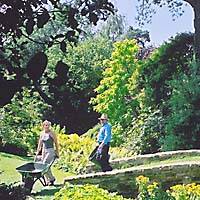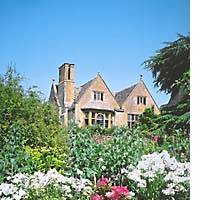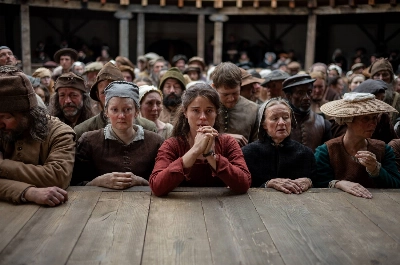Gentle hills dotted with sheep and ancient villages set beside flowing streams: Scenes such as these attracted William Morris and other members of the Arts and Crafts movement to the Cotswolds in the late 19th century.
The Cotswolds is still a lovely part of rural England, and if you visit the area you will surely want to take the winding road to Hidcote Manor Garden -- one of the most celebrated gardens in the world. There you will find a 17th-century manor house hiding among old-fashioned roses, lavender and clematis. But Hidcote offers much more than a picturesque cottage garden: It is a living labyrinth of nearly 30 different gardens that unfold as we explore them.
This remarkable garden was the creation of a cultivated American, Maj. Lawrence Johnston, who settled in England in the Edwardian era. His wealthy mother, Gertrude Winthrop, bought the manor house, surrounding farmland and the small village of Hidcote Bartrim in 1907, thinking that her son would like to become a "gentleman farmer." But Johnston had other ideas, and between 1907 and 1930 he transformed 4 hectares of this windy Gloucestershire hillside into a unique garden. Influenced partly by Arts and Crafts informality and partly by Italian gardens with their terraces and vistas, this quiet bachelor created a masterpiece that continues to delight visitors today.
I visited Hidcote on a hot summer's day and, since it is so large and varied, I will mention just a few particularly memorable areas. The first is the White Garden, which you approach through a mass of fragrant roses, flowering stocks and fluttering butterflies, and which is tucked inside the Old Garden by the manor house. Inside this small jewel of a garden is a pleasing pattern of flower beds edged by low-growing box shrubs. These spring up, at each of the four corners, into the shapes of plump birds formed by topiary, the art of shrub clipping. In the late 19th century, topiary became fashionable when the Arts and Crafts movement revived interest in the simple, modest beauty of the preindustrial age.
The White Garden was one of Johnston's early creations, and although he left no notebooks behind, the gardeners at Hidcote continue to choose flowers, grasses, herbs and trees in tune with his ideas. The dark-green hedges, the birds looking pertly over their shoulders, and the cool combination of white, green and silver plants created, on that hot day in August, a magical moment of coolness.
Walking on through old gateways, finding sudden "doors" opening up in high hedges of hornbeam, holly or yew, you might discover a lush pond, a simple circle of grass, or a lawn bordered with brilliant red and orange flowers. This is the famous Red Border, and whereas the White Garden is as quiet as falling snow, the Red Border is crackling with flowery flames. In summer, it peaks in a rich tapestry of color. Dahlias raise their perfect heads above clusters of dainty verbenas, and tall canna lilies with spotted petals provide a luscious, exotic note.
There are more than 60 varieties of plants in each of these gorgeous borders. Some, such as the purple-leaved cherry tree, are permanent features; others, such as the canna lilies, are brought in from the nursery at the start of summer. In Johnston's day, wealthy people had a team of gardeners to look after their plants and do all the hard work of digging, lifting, pruning and trimming.
Bordering on the inspirational
Few of us could attempt such herbaceous borders today, but they can still inspire us with useful ideas. For example, the foliage in the Red Border is almost as important as the flowers, including as it does plants such as velvety-purple sage, and the glittering bronze leaves of the dahlia "Bishop of Llandaff." Furthermore, the odd touch of deep blue, from a clematis or delphinium, makes the reds seem even richer, and shows us how one color can make another more intense. Like the influential gardener Gertrude Jekyll, Johnston was a painter, and his artistic talent still shines throughout the garden.
At the end of the Red Border two quaint pavilions invite us to rest for a moment and appreciate a dramatic view that opens up to the south. This is the Long Walk, an extremely long sweep of lawn, which makes a fine, simple contrast to the complex gardens that lie beyond. If you follow the lawn to the end, it will reward you with a marvelous view of rural England in the valley below. Or if you branch off into the Stream Garden, you will find another cool oasis, filled with the scent of lilies and the voices of doves in the trees, waiting for dusk.
Finally, in the Pillar Garden, where tall pillars of yew stand about like giant chess pieces waiting to move, I was pleased to find some old friends from Japan. These were the spotted, orange tiger lilies (Lilium tigrinum) or oni-yuri (meaning "devil's lily") that still grow wild on Japanese mountains. Pale-yellow day lilies (Hemerocallis citrina), or yusuge, with their slender leaves and ephemeral flowers. And pure-white Japanese anemones (Anemone japonica) or shumeigiku, whose graceful flowers appear in many English gardens as summer turns to autumn.
In 1948, in failing health, Johnston left Hidcote Manor Garden to the National Trust and retired to yet another fine garden he had made on the French Riviera. Recently, it has become fashionable for wealthy people to spend lots of money making an "instant garden," but Johnston's legacy shows us that gardening is an art, as well as a craft, and that it takes time and respect for the living world to make something worthwhile. As one visitor, a busy London garden designer, commented, "No amount of money could buy a garden like this."




















With your current subscription plan you can comment on stories. However, before writing your first comment, please create a display name in the Profile section of your subscriber account page.